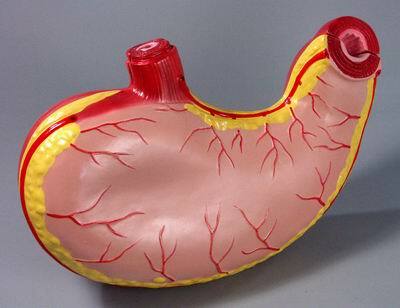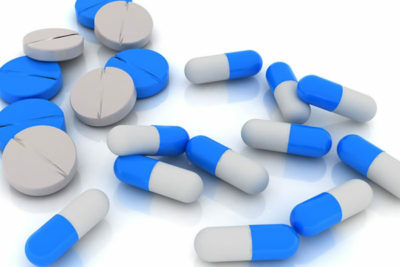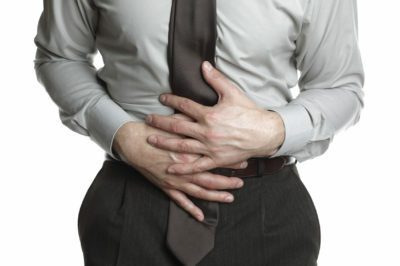1 Clinical picture of the disease
One of the most insidious varieties of gastritis is atrophic, developing most often in men of elderly and middle age.
Do you have gastritis?
GALINA SAVINA: "How easy is it to cure gastritis at home for 1 month." A proven method is to write down a recipe. ..! "Read more & gt; & gt;
Under the influence of certain causes, the cells of the stomach undergo the so-called "atrophic degeneration" and can no longer perform their functions - to produce components of gastric juice. Instead, they begin to excrete mucus. Atrophic gastritis usually goes along with a decreased or increased acidity of the stomach. But the danger of the disease is not even that it contributes to the deterioration of the digestive tract. Today it is known that atrophic gastritis and stomach cancer are related. Atrophic gastritis is a harbinger of a more complex disease.
The insidiousness of the disease lies in the fact that in the first stages the disease passes almost without symptoms.

We recommend that you read
- What kind of gastric gastritis diet is like
- Gastritis gastric nutrition
- Symptoms and treatment methods for digestive tract diseases
- Effective remedy for gastritis and stomach ulcer
A small discomfort is very easy to ignore or take for a malaise.
All forms of atrophic gastritis have symptoms similar to each other. After eating, even in small amounts, patients often complain of a feeling of heaviness in the solar plexus. There are manifestations of LCD pathology: smell from the mouth, rumbling in the abdomen, flatulence, the appearance of constipation, less often - diarrhea.
There are some other symptoms that do not directly affect the gastrointestinal tract: a sharp decrease in body weight, a lack of vitamin B12, signs of anemia, icterus of the skin, tingling of the tongue, headaches. There may be a manifestation in the oral cavity. The hormonal background is broken.
For diagnostics apply various methods, the use of CT, ultrasound, MRI, X-ray exhaustive information does not.
In order to obtain all the data and to prescribe the correct treatment of atrophic gastritis, varieties of gastroscopy and endoscopy are more often used. Gastroscope allows you to determine the thinning of the walls of the stomach. Examination of the gastrointestinal tract allows to obtain data on the state of the glands of the stomach.
The most convenient modern method of study is gastropanel, which allows a non-invasive way to assess the state of stomach activity. The method is based on the identification of three indicators: the pepsinogen protein responsible for the production of HCL, the antibody Helicobacter pylori and the hormone gastrin 17, which controls the production of acid and the regeneration of the walls of the stomach.
-
 IMPORTANT TO KNOW! Gastritis? Ulcer? To have a stomach ulcer not turned into cancer, drink a glass. ..Read the article & gt; & gt;
IMPORTANT TO KNOW! Gastritis? Ulcer? To have a stomach ulcer not turned into cancer, drink a glass. ..Read the article & gt; & gt;
2 Manifestation of pathology
Atrophic gastritis can be of different types. Depending on the stage, a person can develop:
- superficial;
- sharp;
- is moderate;
- chronic atrophic gastritis.

Superficial atrophic gastritis is considered only as a sign of possible inflammation of the mucous membrane. This is the earliest stage in which manifestations are practically not noticeable, therefore it can only be determined by endoscopy. With the instrumental method of investigation, the following manifestations are found:
- hypersecretion of cells - can be established only by indirect evidence;
- the thickness of the walls of the stomach is normal;
- degeneration of the epithelium - at a moderate level.
Contrary to popular belief, chronic atrophic gastritis is an independent disease, and not a transformation of the acute form of a stomach disease. Chronic gastritis is characterized by a prolonged, progressive destruction of the cells of the stomach, with predominantly dystrophic, and not inflammatory processes. Essentially, the motor, secretory and other functions of the stomach change.
-
 Gastroenterologist. IMPORTANT: "I beg you, if you began to worry about abdominal pain, heartburn, nausea, do not in any way do gases. .."Read more & gt; & gt;
Gastroenterologist. IMPORTANT: "I beg you, if you began to worry about abdominal pain, heartburn, nausea, do not in any way do gases. .."Read more & gt; & gt;
In chronic form, the disease affects not only the stomach, but also other organs: pancreas and endocrine glands. As a result of intoxication, the nervous and circulatory systems are involved in the development of the disease.
The appearance of the symptoms of the disease is associated with a decreased or increased acidity of the gastric juice.

3 Methods of examination of the body
The most significant methods of examination are endoscopy, pH measurement and blood testing. With the help of instrumental methods, atrophic gastritis can be identified by the following features:
- organ wall can be of usual thickness or too thin;
- presence of gastric pits large width;
- activity of the glands is greatly reduced;
- , vacuolization of glands is observed;
- packed epithelium;
- is smoothened by the mucosa membrane;

Moderate atrophic gastritis is a very conventional designation of a stage in which only a partial, mild degree of cell transformation is observed. Identify the disease at this stage can only be one way - by determining the area of the gastric mucosa of the number of affected cells. At the same time, tissue changes are analyzed.
In this disease, the symptoms will be exactly the same as in the acute form: acute pain, which, however, does not always appear( more often after taking hot, fried foods), a frequent feeling of discomfort after eating.
ADVICE FROM THE MAIN GASTROENTEROLOGIST
Korotov SV: "I can recommend only one remedy for the rapid treatment of Ulcer and Gastritis, which is now recommended by the Ministry of Health. .." Read the reviews & gt; & gt;
Acute, or active, gastritis is characterized by exacerbation of inflammatory processes. There is edema of the tissues, the destruction of the epithelium up to the erosion of the mucosa( in rare cases) and leukocyte infiltration beyond the organ.
Symptoms of acute form: severe pain in the stomach, diarrhea, fever, loss of consciousness - right up to the coma.

4 Types of the disease
The following types of atrophic gastritis are distinguished:
- antral;
- focal;
- diffuse.
Focal atrophic gastritis is characterized by the appearance of areas with pathological processes in the stomach tissues. In some cases, the disease passes with increased acidity. The increase in the amount of hydrochloric acid in this disease is usually explained by the fact that healthy areas of the stomach tissue compensate for the work of the affected. In general, the symptoms of focal atrophic gastritis does not differ from usual.

The most common symptom is the intolerance of certain foods: too fatty foods, dairy products, etc. After eating this food, you may experience vomiting, stomach pain, and heartburn. Precisely establish the diagnosis of laboratory and instrumental help.
Antral atrophic gastritis develops in the lower part of the stomach bordering the duodenum. The manifestations of this disease are very bright and have the appearance of scarring. Visually is a sealed tube. Symptoms of dyspepsia are moderately expressed: the appearance of belching after eating, pain in the solar plexus, worsening appetite, nausea in the mornings, a noticeable decrease in body weight. Acidity remains at the same level or, which happens much more often, decreases somewhat.
An antral gastritis is assigned instrumental examination, as a result, the change and deformation of the walls of the stomach is usually detected, as well as the decrease in peristalsis due to the rigidity of the walls. Often diagnosed tumors on the mucosa and ulcer processes.

Another type - diffuse gastritis. This disease is an intermediate stage that occurs after the onset of superficial deformations of the walls of the stomach and before dystrophic changes. The most obvious sign is the presence of foci of degeneration of the glands of the stomach and a violation of their activity, the appearance of immature cells. Other symptoms of the disease are the presence of microstructural lesions and deepening of the gastric pits.
5 Treatment Therapy
Due to the fact that there are many forms of the disease, atrophic gastritis does not have a general approach in treatment. It is established that the begun process of atrophy can not be corrected, because the damaged cells do not return to their original state.
Despite this, methods have already been proposed that allow to effectively treat atrophic form of gastritis, regardless of its type and stage, to stop its further development.

All forms of treatment are based on survey results, since each case requires a special therapeutic approach. Treatment scheme consists of several stages.
The first stage - the eradication of Helicobacter pylori, is necessary in the case when bacteria have a strong effect on the course of the disease. The main tasks at this stage are:
- suppressing the development of bacteria, overcoming their resistance to antibiotics;
- reduction of dyspeptic phenomena, alleviation of the condition by the use of inhibitors;
- shortens the duration of treatment;
- reduced the number of medications used to reduce the occurrence of side effects.
At the second stage, attempts are made to influence the development of autoimmune processes. A method that would fully affect the development of atrophic hyperplastic gastritis has not yet been found. Usually hormones and immunocorrectors are prescribed at this stage, but they do not always give the desired effect.

The third stage is pathogenesis therapy. During this period, prescribe drugs from various groups:
- Means for facilitating digestion.
- Parenteral injections to eliminate the lack of vitamin B12.
- In some cases, effective mineral water - they have a beneficial effect on the production of hydrochloric acid.
- To reduce inflammation use drugs that include plantain juice, for example, Plantaglucid. Alternatively, you can directly use the juice of plantain.
- Treatment of inflammation promotes Riboxin, which is increasingly prescribed to patients.
- Assign drugs that allow regulating motor function of the intestine( cisapride or some others).
- In order to protect the mucous membrane, bismuth nitrate is used, Kaolin, Vicair.
After the end of active treatment, there comes a period of remission. At this time, the main tasks - the restoration of digestive functions, the completion of the necessary substances for this.
6 Diet for the disease
In order for the treatment of atrophic gastritis to give results, a special diet is prescribed to the patient, which he must adhere to throughout the period of treatment and remission. In any case, with this disease during the organization of food, there may be some difficulties. Before treating atrophic stomach gastritis, the doctor prescribes one of four types of diets developed by MI Pevzner.
Diet 1. It is prescribed only when the symptoms of inflammation gradually subside. This way of nutrition helps to normalize the work of the stomach. Cold and hot dishes are excluded from the daily menu of the patient. Limit the use of fiber-rich foods. In total, the diet includes about 11 dishes.
Diet 1a - it is recommended to adhere to patients in the first days of treatment. The purpose of this type of diet is to maintain a gentle diet, reduce stress. The food should be liquid or in the form of puree, the method of cooking - steaming or in water.
Diet 2 is considered basic, aimed at stimulating the glands. Nutrition of patients must be diverse. The menu includes fish, lean meat, sour-milk and flour dishes, fruits and vegetables. Products can be fried in a small amount of oil, cook, stew and bake. There are about 30 dishes in the menu.
Diet 4 - with enteral syndrome is designed to improve the functioning of the stomach, reduce inflammation of the mucosa. Dairy products are excluded, since their intolerance is observed. To eat it is necessary fractional, that is often, but in small portions. After the symptoms of inflammation pass, patients are transferred to a more complete diet - number 2.
- 1 Clinical picture of the disease
- 2 Manifestation of the pathology
- 3 Methods of examination of the body
- 4 Types of the disease
- 5 Therapeutic therapy
- 6 Diet for the disease
The inflammatory process that takes place on the stomach mucosa is called atrophic gastritis. With this disease, the number of healthy cells is greatly reduced, a precancerous condition arises. Before starting treatment for atrophic gastritis, you should find out the reasons for its development. Gastritis symptoms and treatment is completely dependent on the stage of the development of the disease.



